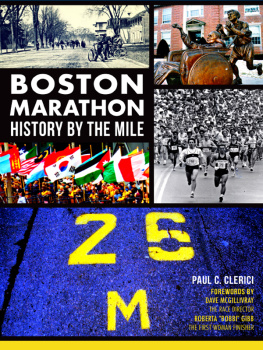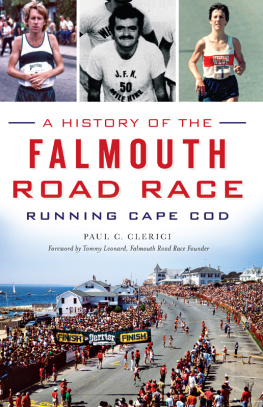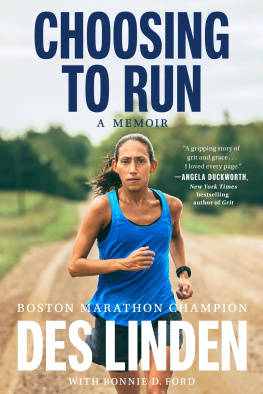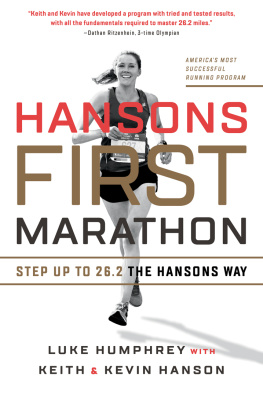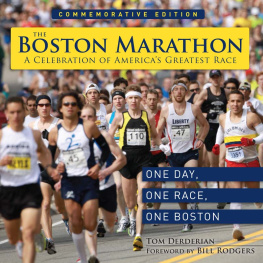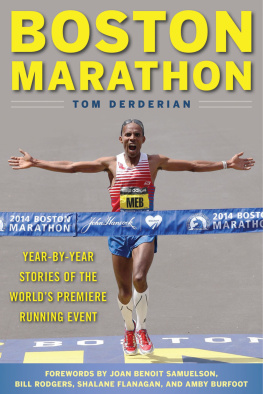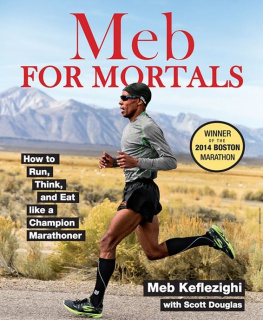

Published by The History Press
Charleston, SC 29403
www.historypress.net
Copyright 2014 by Paul C. Clerici
All rights reserved
Boston Marathon, BAA Marathon, and the BAA unicorn logo are trademarks of the Boston Athletic Association. Use of these trademarks without written permission from the Boston Athletic Association is prohibited. Boston Marathon History by the Mile is not an official publication of the Boston Athletic Association.
Front cover, clockwise from top left: With bicyclists leading the way, and a few waiting on the sidewalk at right, the field of the third annual Boston Marathon in 1899 makes its way up the dirt road of Main Street in Ashland. Courtesy Ashland Historical Society; Located on the Center School grounds near Hopkinton Town Common is the Yes You Can statue of Team Hoyt, the inspirational multiple-sport duo of Dick Hoyt and his son Rick Hoyt, a spastic quadriplegic who lives with cerebral palsy. Photo by Paul C. Clerici; The streets of the Boston Marathon are filled in the early miles. Jeff Johnson photo courtesy New England Runner; The last mile marker26 Mis located on Boylston Street, just 385 yards from the finish line. Photo by Paul C. Clerici; Nations flags and thick crowds line the Boylston Street approach to the finish line. Photo by Frank Clerici Sr.
First published 2014
e-book edition 2014
ISBN 978.1.62585.003.4
Library of Congress Cataloging-in-Publication Data
Clerici, Paul C.
Boston Marathon history by the mile / Paul C. Clerici ; foreword by Dave McGillivray ; foreword by Roberta Bobbi Gibb.
pages cm
print edition ISBN 978-1-62619-475-5 (paperback)
1. Boston Marathon--History. 2. Neighborhoods--Massachusetts--Boston--History. 3. Boston (Mass.)--History. I. Title.
GV1065.22.B67C54 2014
796.42520974461--dc23
2014004272
Notice: The information in this book is true and complete to the best of our knowledge. It is offered without guarantee on the part of the author or The History Press. The author and The History Press disclaim all liability in connection with the use of this book.
All rights reserved. No part of this book may be reproduced or transmitted in any form whatsoever without prior written permission from the publisher except in the case of brief quotations embodied in critical articles and reviews.
I dedicate this book to my parents, Frank Clerici Sr. and Carol Hunt-Clerici; my brother and sister-in-law, Frank Clerici Jr. and Regina Clerici; and my late brother, David Clerici.
I wish to also dedicate this book to all the Boston Marathon athletes, volunteers, spectators, supporters, officials, media, and their families and friends for providing its strength, excitement, history, and enduring spirit.
CONTENTS

From west to east, the Boston Marathon course travels through eight towns and cities: Hopkinton, Ashland, Framingham, Natick, Wellesley, Newton, Brighton/Brookline, and Boston. Courtesy New England Runner.
FOREWORD
It is truly an honor and pleasure to have been asked by Paul Clerici to write a foreword for his new book, Boston Marathon History by the Mile.
Having run and finished the Boston Marathon forty-one consecutive times (as of 2013), having helped to direct it for twenty-six years (as of 2013), having lived in a house right on the course, and having been up and down the course about a million times, I guess you could say I am quite intimate with every pothole and every streetlight that exists along the course!
People always ask me, So, what makes Boston so special?
Certainly the history and the tradition of the race come to mind right away. However, for me, its also the course itself. There is just something very special about this courseit has character like no other one in the world that I have run (and Ive run 128 marathons).
The quaint start in Hopkinton. The downhills through Ashland and into Framingham and across the railroad tracks. The Natick Town Common. And the cheering and hugging and kissing from the young ladies of Wellesley College cannot be described in wordsyou just have to experience it yourself.
The gradual hill no one plans for that goes right over Route 128 toward the Newton-Wellesley Hospital. Taking a right at the Newton Fire Station at seventeen and a half miles and taking on the hills of Newton, the last one being Heartbreak Hill. Passing the Johnny Kelley statue and then running past the roar of the Boston College students.
Then seeing the CITGO sign for the first time as you turn left onto Beacon Street with four miles to go. Crossing over the Mass Pike, seeing Fenway Park to the right, crossing over the One Mile to Go mark painted on the road in Kenmore Square. And then the famous right on Hereford, left on Boylston and the final six hundred yards to the finish line at the Boston Public Library.
Oh, yes, and there are a few spectators along the 26.2-mile course to cheer you on!
I was seventeen when I ran my first Boston. It wasnt pretty. And I was a bandi a bandiwell, I just cant say that word. Lets just say that at the time, I was too young to officially enter; you had to be eighteen years old.
I collapsed in the Newton hills and was immediately transported to the Newton-Wellesley Hospital. My grandfather, who lived near the course, was waiting for me at Coolidge Corner. But I never arrived. He said hed be back next year, waiting for me. Sadly, however, he died two months later.
I dedicated that race to him but once again dropped out at mile 21.5. Little did I know, though, that it was at that exact location where my grandfather was buried in the Evergreen Cemetery, right there on the marathon course. He said he would be there, and he was, spiritually. I finished the race that year and have every year since.
In 1987, there was a wheelchair division accident and an accident with the start of the race in which the lead runners tripped on the rope being held to hold the runners back before the gun fired. I was then offered the job as technical coordinator for the 1988 Boston Marathon. My conundrum was the decision to continue to run in the race or to help runthat is, directthe race.
I took the job. That year, I simply imposed a controlled start for the wheelchair athletes and replaced the rope with a human chain of volunteers. Voilaproblem fixed! And I have had the job for twenty-seven years.
At the conclusion of the 1988 marathon, my first year helping to manage the race, I decided to head back to the start and run the course myself, which I did and finished last, about eleven oclock at night. Ive been last in the race ever since; that is, for the past twenty-six years. But frankly, I am quite okay with that.
As for helping to direct the race, my fondest moment, other than that first year, was the 100th running of the race in 1996, when we had to figure out a way to get more than thirty-eight thousand runners across a startling line that is only thirty-nine feet wide. And we didin less than thirty minutes.
Then there was a noreaster in 2007, and we had to deal with a storm of epic proportions, which we did. And then there was 2012, the inferno year, when temperatures reached almost ninety degrees. We almost cancelled the race the day before, but we asked the runners to take personal responsibility and offered them the choice to defer to the following year if they determined that it would just be too hot. We went ahead with the race and dealt with the heat as best we could.
Next page
